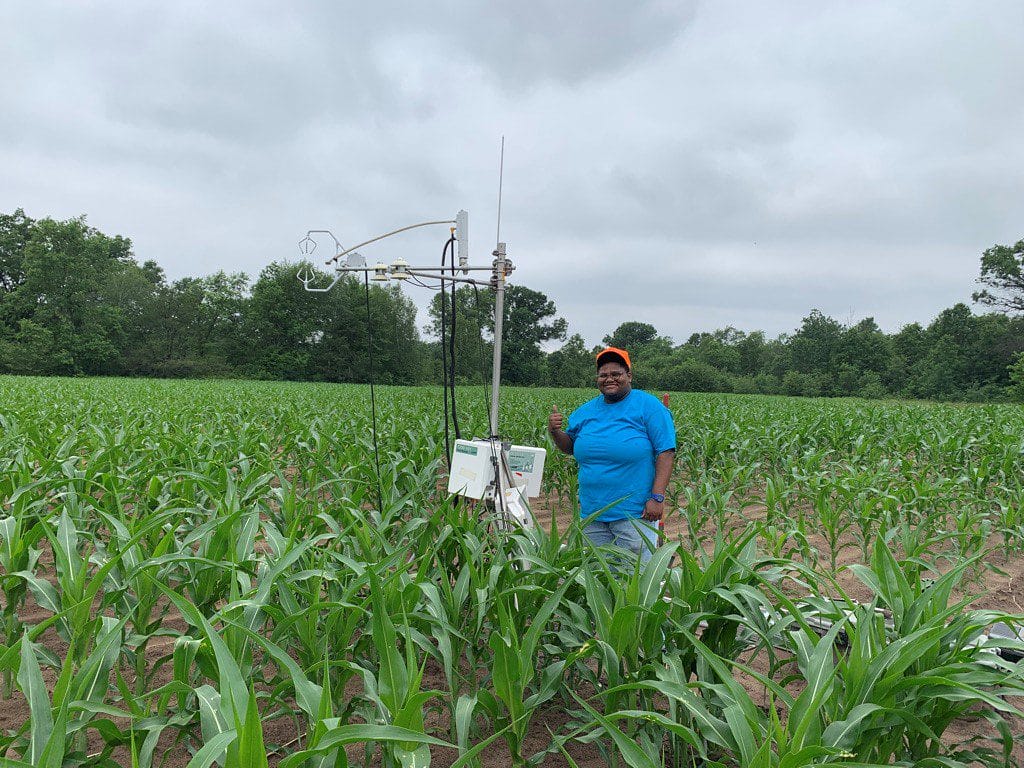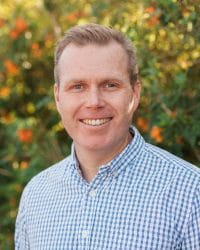

CALS students learn programming from National Science Foundation data project
Photo: Sharifa Brevert, BS’21, during an installation of a research station in Adams County, Wisc. Stations like this are utilized in BSE 375 (now renumbered as BSE 380): Introductory Data Science for the Agricultural and Life Sciences. Photo courtesy of Paul Stoy.
Located north of Bozeman, the rocky peaks of Montana’s Bangtail Mountains overlook nearby pine forests and scattered grasslands. Although she has never visited the area, UW–Madison student Paige Sauer is well acquainted with one of the meadows there.
Home to a geographical observation station that generates data streams, the meadow is one Sauer learned of in an online course last summer called Introductory Data Science for the Agricultural and Life Sciences.
“I’m always in Wisconsin. It’s where I live, it’s where I go to school,” says Sauer, a senior majoring in biological systems engineering. “I’ve never been to [the Bangtail Mountains] or had even heard about them before the class, but I feel like I know everything that’s going on there.”
The course, BSE 380, which is offered through the College of Agricultural and Life Sciences (CALS), takes place this summer online, June 20 to August 14, through UW–Madison Summer Term. Summer Term courses are offered in person and online in 3-, 4- and 8-week sessions so students can take a course from almost anywhere or choose to spend their summer in Madison.
This summer, BSE 380 will be offered asynchronously with flexible due dates and content to facilitate a summer of learning alongside other activities.
Programming basics
“My goals are to work with students to create a learning environment that can accommodate busy summer schedules, and for students to have a strong grasp of the basic principles that form the foundation for creative work,” says Paul Stoy, associate professor of biological systems engineering in CALS who teaches the course. “A number of projects from previous versions of this course have resulted in scientific publications, and with great ideas and enthusiasm, this is always a possibility.”


BSE 380 is designed to teach computer programming at a basic level. In the course, students learn to gather, analyze, interpret and visualize data to creatively address technical, business and environmental challenges. As they build their data science skills, they work with real-world information from the agricultural and life sciences fields, which helps bring their coursework to life.
Students use a free, open-source software called Python for coding, and the course is available to all students regardless of their major.
“Programming is not just for science majors. Anybody with a good work ethic and creativity can become a great programmer,” says Stoy. “I have taught the basics of computer programming for over 10 years now, and I always love to see the creative solutions that students come up with to address questions about environmental systems.”
Cheesy data
In previous semesters, students accessed data from sites Stoy studied in Montana. Now students will access data from research stations in northern Wisconsin to connect with more unique opportunities within the Badger State.
“There are so many rich data resources in the world, including for agricultural systems and natural systems, but we have to know how to use [the data] to be able to benefit from it,” explains Stoy. “Data science holds the key to unlocking how to manage systems for productivity and sustainability.”
This summer, students will use real-world observations collected from a National Science Foundation project in northern Wisconsin headed by one of Stoy’s colleagues, Dr. Ankur Desai, called CHEESEHEAD19. The goal of this intensive field campaign is to understand how the rich and diverse landscape of northern Wisconsin interacts with the atmosphere to help determine its dynamics. The data collected by CHEESEHEAD19 has proven useful for understanding everything from renewable energy potential — namely, solar and wind — to forest water use, atmospheric science and more.
The course begins slowly, but ramps up with the goal that every student reaches the same coding level by the end of the course. By the end of the summer, students will use the data they analyzed from CHEESEHEAD19 to produce a report with numerous figures, tables and visual aids.
“The diverse environmental data sets collected during the CHEESEHEAD19 campaign are ideal for teaching the principles of computer programming and data science,” says Stoy. “What I really want is for students to say ‘I can do that’ when they see a job application that requires computer programming.”
Information in this blog was first shared in this CALS news article by Nicole Miller. See the Summer Term website for more information on getting ahead and achieving your academic goals with summer courses.
Published on Jun 15 2022
Last Updated on May 19 2025
Categories: News, Summer Term
Tags: agricultural and life sciences, courses, online education
Previous Post
New course explores Chinese hip hop
